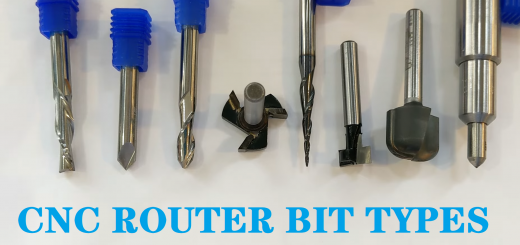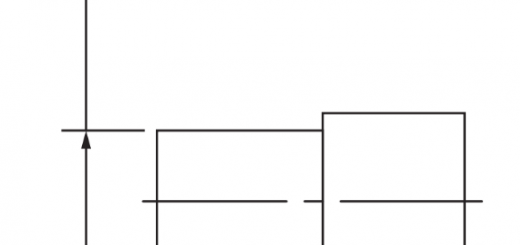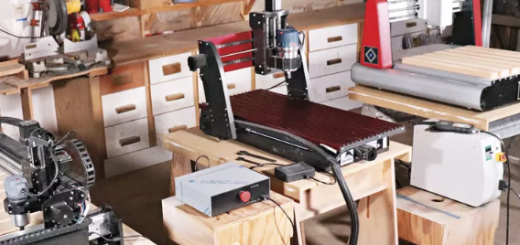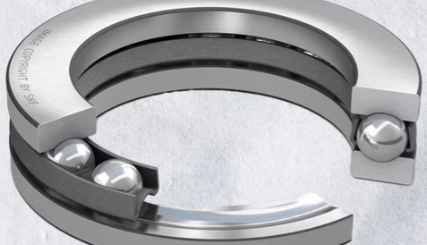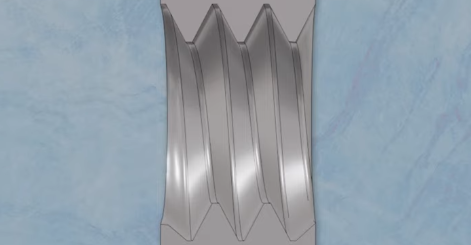How to Cut All Thread – Best Ways to Cut Internal, External, Left-Hand, Right-Hand Threads
Learning how to cut threads on the lathe can be quite a daunting prospect. It’s the perfect moment to brush up on threading skills, so this journey will be shared together. In today’s guide, four different methods for cutting single-point threads on the lathe will be explored. These methods will be applied to cut both internal and external, left and right-handed threads.
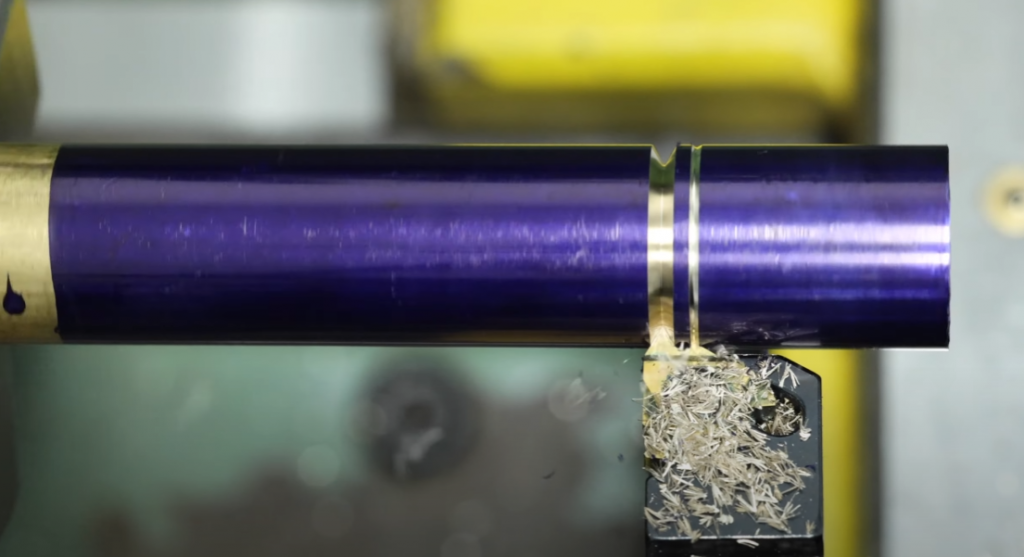
How Is the Screw Thread Formed?
Let’s start by understanding a little bit about how screw threads are formed. This is a threading tool, and it has a 60° profile which is what we need for the most common metric and imperial threads. It’s a form tool, so the shape that you see here is what we’ll end up with in the workpiece when we plunge the tool.
Key Components of Thread:
- Lead Screw: This is crucial as it pulls the carriage, and therefore the cutting tool, along the workpiece as it rotates, forming a helix shape.
- Half Nuts: Attached to the carriage and operated by a lever, these engage with the lead screw to move the carriage at a fixed rate.
- Change Gears: These gears couple the spindle and lead screw together, determining the pitch of the thread to be cut.
How To Set Up the Lathe for Thread Cutting?
Now that we know we can cut a decent profile, we need to find a way to couple the spindle and the carriage. This will allow the tool to translate along the workpiece as the workpiece is rotating, resulting in a helix. This is a lead screw, and this is what’s going to pull the carriage and therefore the cutting tool along the workpiece. You’ll generally find it at the front of the machine.
Gear Ratios and Pitch
The fixed rate is determined by two factors:
- The pitch of your lead screw.
- The gear ratio coupling the spindle to the lead screw.
It’s the combination of those two things that determine the pitch of the thread that we’re going to cut into our workpiece. The spindle and lead screw are coupled together by a train of gears known as change gears.
Configuring Gear Ratios
On a mini-lathe, we’ve got a driving pinion and six gears (A, B, C, D, E, and F). They’re laid out in a compound train and mesh together as per the diagram. It’s as simple as looking at the chart, either the metric or the imperial one, working out what thread pitch you want to cut, and then selecting the appropriate sized gear wheels and installing them in the correct places in the gear train.
Best Thread Cut Method 1: The Plunge Method
The first method is called the plunge. In this method, you plunge the tool into the work at a 90° angle, then traverse the tool to cut the thread, and finally retract the tool using the cross-slide.
- Pros: Easy to execute and remember
- Cons: High tool pressure as the tool is cutting on both sides simultaneously, which can lead to chip jamming, chatter, and poor surface finish.
Steps:
- Prepare the Stock: The first thing we need to do is to reduce the size of our stock to the normal major diameter of the thread. For an M10 by 1.5 thread, this is 10 mm, although it is often easier to go slightly under this.
- Set Up the Grearbox: We need to set my lathe gearbox to the correct thread pitch. If you don’t have a gearbox on your lathe, refer to your lathe instructions and work out which change wheels you need to change to cut the correct thread pitch.
- Zeroing the Dials: Zero the dials so that we can keep an eye on the depth of cut. Wind the tool in until it just makes contact with the workpiece and we get a very light scratch on the surface. At this point, set the cross-slide hand-wheel indicator to zero.
- The Threading Dial: The threading dial allows us to select the safe points that we can re-engage the lead screw. For a 1.5 mm thread pitch, engage on numbers like 1, 3, 5, 7, 9, 11.
- Cutting the Thread: With the machine running, keep an eye on the threading dial and engage the half nuts when the correct number comes around. This first pass is known as the scratch pass, made at almost zero depth of cut. Then, retract the tool, wind the carriage back to the start, and take the next cut.
Best Thread Cutting Method 2: Using the Compound Slide
In this method, you turn the compound slide to just under 30° (for a 60° threading tool) so that the tool cuts on only one face as it advances into the work. This reduces tool pressure and improves surface finish, especially with harder materials.
- Pros: Reduced tool pressure, Improved surface finish
- Cons: Requires setting up the compound slide at the correct angle
Steps:
- Adjust the Compound Slide: Turn the compound slide to just under 30° so that the tool cuts on only one of its faces, reducing tool pressure and improving surface finish.
- Dial Indicator: Set up a dial indicator on the tool post to measure the depth of cut, as you can’t use the hand wheels on the compound slide due to cosine error.
- Scratch Pass: Touch off on the work, set the hand wheel dials to zero, and zero out the dial indicator on the compound. Then, perform a scratch pass to check the thread pitch.
- Cutting the Thread: Wind the cross slide back to zero, apply depth of cut with the compound slide, start the machine, and engage the half nut. Repeat the process until you get close to the final size, measuring the threads on each pass.
Thread Cutting Method 3: Threading Away from the Headstock (Right-Hand Threads)
This method involves running the lathe in reverse and turning the cutting tool upside down. The tool now moves away from the headstock as you cut the thread. This method is less stressful as there is no risk of crashing into a shoulder or the chuck.
- Pros: Less risk of crashing the tool, Can run the lathe faster for better surface finish on harder materials
- Cons: May unscrew screw-on chucks, Requires a different tool setup
Steps:
- Reverse Setup: To avoid crashing into the chuck or shoulder, you can thread away from the headstock. This involves running the lathe in reverse and turning the tool upside down.
- Cutting Process: Ensure the spindle and lead screw are rotating in opposite directions. Engage the half nut and cut the thread away from the headstock.
Thread Cutting Method 4: Always Engaged Lead Screw Method (Imperial/Metric Thread Conversion)
This method is used when cutting imperial threads with a metric lead screw, or vice versa. You engage the lead screw once and leave it engaged until the cut is finished. This avoids disengaging the lead screw, which would ruin the thread due to the conversion between imperial and metric.
- Pros: Allows cutting any thread pitch or diameter with the right gear ratios
- Cons: More nerve-wracking as you have to stop the lathe before crashing, Requires putting the lathe in reverse for each new cut
Steps:
- Setup: Engage the lead screw once and leave it engaged until the cut is finished. This method is crucial for cutting imperial threads with a metric lead screw or vice versa.
- Cutting Process: Start the lathe, engage the lead screw, make the cut, turn off the lathe, and let it come to a stop. Back the tool out, put the lathe in reverse, bring the tool back to the start, and continue cutting.
Method To Cut Internal Threads
- Using an Internal Threading Tool: For internal threads, the process is almost identical to external threading. Use an internal threading tool, zero the cross slide, and apply depth of cut with the compound.
- Scratch Pass and Cutting: Perform a scratch pass, engage the half nut, make the cut, and repeat the process until the thread is formed.
Method to Cut Left-Hand Threads
- Reversing the Lead Screw: To cut left-hand threads, reverse the direction of the lead screw. This can be done by adding an extra idler gear into the gear train or using a lever if your lathe has one.
- Cutting Process: Prep the stock as usual, engage the lead screw, and cut the thread away from the headstock.
Practical Tips for Success
- Bluing the Workpiece: This helps in seeing where the cuts are being made more clearly.
- Measuring Tools: Use a thread micrometer or thread wires to measure the threads for accuracy.
- Handling Chatter: Opt for lighter cuts and possibly increase the speed to reduce chatter.
Threading on a lathe requires precision and practice. By understanding and applying these four methods—plunge, compound slide, threading away from the headstock, and always engaged lead screw—you can efficiently cut various types of threads. Remember to always measure your threads carefully and adjust your techniques based on the material and thread type. Whether you’re making a custom bolt or a fidget toy, mastering these methods will greatly enhan

